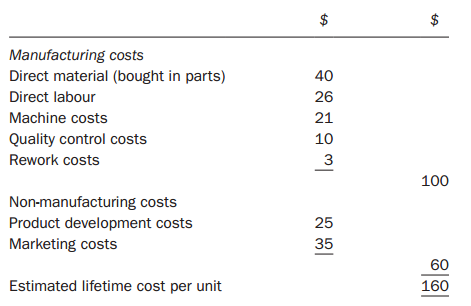Cam Co. manufactures webcams, devices which can provide live video and audio streams via personal computers. It
Question:
Cam Co. manufactures webcams, devices which can provide live video and audio streams via personal computers. It has recently been suffering from liquidity problems and hopes that these will be eased by the launch of its new webcam, which has revolutionary audio sound and visual quality. The webcam is expected to have a product life cycle of two years. Market research has already been carried out to establish a target selling price and projected lifetime sales volumes for the product. Cost estimates have also been prepared, based on the current proposed product specification. Cam Co. uses life cycle costing to work out the target costs for its products, believing it to be more accurate to use an average cost across the whole lifetime of a product, rather than potentially different costs for different years. You are provided with the following relevant information for the webcam:
Projected lifetime sales volume ..............................................................................50 000 unitsTarget selling price per unit ............................................................................................$200Target profit margin (35% selling price) ..........................................................................$70Target cost per unit .........................................................................................................$130Estimated lifetime cost per unit (see note below for detailed breakdown) .............$160
Estimated lifetime cost per unit:

Estimated lifetime cost per unit 160The average market price for a webcam is currently $150.The company needs to close the cost gap of $30 between the target cost and the estimated lifetime cost. The following information has been identified as relevant:1. Direct material cost: all of the parts currently proposed for the webcam are bespoke parts. However, most of these can actually be replaced with standard parts costing 55 percent less. However, three of the bespoke parts, which currently account for 20 percent of the estimated direct material cost, cannot be replaced, although an alternative supplier charging 10 percent less has been sourced for these parts.2. Direct labour cost: the webcam uses 45 minutes of direct labour, which costs $34.67 per hour. The use of more standard parts, however, will mean that whilst the first unit would still be expected to take 45 minutes, there will now be an expected rate of learning of 90 percent (where ?b? 5 20.152). This will end after the first 100 units have been completed.3. Rework cost: this is the average rework cost per webcam and is based on an estimate of 15 percent of webcams requiring rework at a cost of $20 per rework. With the use of more standard parts, the rate of reworks will fall to 10 percent and the cost of each rework will fall to $18.
Required:(a) Recalculate the estimated lifetime cost per unit for the webcam after taking into account points 1 to 3 above.(b) Explain the ?market skimming? (also known as ?price skimming?) pricing strategy and discuss, as far as the information allows, whether this strategy may be more appropriate for Cam Co. than charging one price throughout the webcam?s entire life.
Step by Step Answer:






